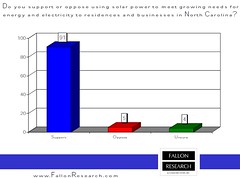That’s three out of five commissioners. I’d call that a majority shaping up to do something in the PSC Energy Committee meeting of 16 July 2011. I couldn’t say what, exactly, since there nothing on the energy committee’s agenda about this. But something solar seems to be in the works.It wasn’t until I entered the training room of Mage Solar in Dublin and saw 40 subcontractors in their solar academy that I got it. The growing solar industry is not just about funky collectors on a roof or left-leaning environmentalists who hate fossil fuel. It is about skilled jobs in manufacturing and construction, about economic development in Georgia, about consumers saving money on their power bill so they can spend it somewhere else, and about empowering people to essentially create their own power plant. This could eventually be big.
-jsq










